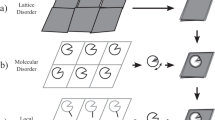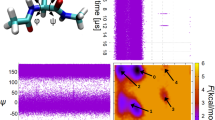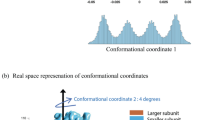Abstract
Proteins are inherently dynamic systems whose motions cover large ranges in both magnitude and timescale. Because of the omnipresence of motion, it is likely that dynamics have important roles in the function of biomolecules. For detailed understanding of a protein's function, the three-dimensional structure and description of its dynamics are therefore required. Structure determination methods are well established, and NMR-relaxation phenomena provide insights into local molecular dynamics; moreover, recently several attempts have been made to detect concerted motion. Here, we present an ensemble-based structure-determination protocol using ensemble-averaged distance restraints obtained from exact NOE rates. Application to the model protein GB3 establishes an ensemble of structures that reveals correlated motion across the β-sheet, concerted motion between the backbone and side chains localized in the structure core, and a lack of concerted conformational exchange between the β-sheet and the α-helix.
This is a preview of subscription content, access via your institution
Access options
Subscribe to this journal
Receive 12 print issues and online access
$189.00 per year
only $15.75 per issue
Buy this article
- Purchase on Springer Link
- Instant access to full article PDF
Prices may be subject to local taxes which are calculated during checkout




Similar content being viewed by others
References
Clore, G.M. & Schwieters, C.D. How much backbone motion in ubiquitin is required to account for dipolar coupling data measured in multiple alignment media as assessed by independent cross-validation? J. Am. Chem. Soc. 126, 2923–2938 (2004).
Clore, G.M. & Schwieters, C.D. Amplitudes of protein backbone dynamics and correlated motions in a small alpha/beta protein: correspondence of dipolar coupling and heteronuclear relaxation measurements. Biochemistry 43, 10678–10691 (2004).
Lindorff-Larsen, K., Best, R.B., DePristo, M.A., Dobson, C.M. & Vendruscolo, M. Simultaneous determination of protein structure and dynamics. Nature 433, 128–132 (2005).
Bouvignies, G. et al. Identification of slow correlated motions in proteins using residual dipolar and hydrogen-bond scalar couplings. Proc. Natl. Acad. Sci. USA 102, 13885–13890 (2005).
Clore, G.M. & Schwieters, C.D. Concordance of residual dipolar couplings, backbone order parameters and crystallographic B-factors for a small α/β protein: a unified picture of high probability, fast atomic motions in proteins. J. Mol. Biol. 355, 879–886 (2006).
Tang, C., Schwieters, C.D. & Clore, G.M. Open-to-closed transition in apo maltose-binding protein observed by paramagnetic NMR. Nature 449, 1078–1082 (2007).
Markwick, P.R.L., Bouvignies, G. & Blackledge, M. Exploring multiple timescale motions in protein GB3 using accelerated molecular dynamics and NMR spectroscopy. J. Am. Chem. Soc. 129, 4724–4730 (2007).
Lange, O.F. et al. Self-consistent residual dipolar coupling based model-free analysis for the robust determination of nanosecond to microsecond protein dynamics. Science 320, 1471–1475 (2008).
Baldwin, A.J. & Kay, L.E. NMR spectroscopy brings invisible protein states into focus. Nat. Chem. Biol. 5, 808–814 (2009).
Markwick, P.R.L. et al. Toward a unified representation of protein structural dynamics in solution. J. Am. Chem. Soc. 131, 16968–16975 (2009).
Bui, J.M., Gsponer, J., Vendruscolo, M. & Dobson, C.M. Analysis of sub-tc and supra-tc motions in protein Gb1 using molecular dynamics simulations. Biophys. J. 97, 2513–2520 (2009).
Vögeli, B. & Yao, L. Correlated dynamics between HN and HC bonds observed by NMR cross relaxation. J. Am. Chem. Soc. 131, 3668–3678 (2009).
Shaw, D.E. et al. Atomic-level characterization of the structural dynamics of proteins. Science 330, 341–346 (2010).
Fenwick, R.B. et al. Weak long-range correlated motions in a surface patch of ubiquitin involved in molecular recognition. J. Am. Chem. Soc. 133, 10336–10339 (2011).
Wüthrich, K. NMR of Proteins and Nucleic Acids (Wiley, 1986).
Vögeli, B. et al. Exact distances and internal dynamics of perdeuterated ubiquitin form NOE buildups. J. Am. Chem. Soc. 131, 17215–17225 (2009).
Vögeli, B., Friedmann, M., Leitz, D., Sobol, A. & Riek, R. Quantitative determination of NOE rates in perdeuterated and protonated proteins: practical and theoretical aspects. J. Magn. Reson. 204, 290–302 (2010).
Olejniczak, E.T., Dobson, C.M., Karplus, M. & Levy, R.M. Motional averaging of proton nuclear Overhauser effects in proteins. Predictions from a molecular dynamics simulation of lysozyme. J. Am. Chem. Soc. 106, 1923–1930 (1984).
Keepers, J.W. & James, T.L. A theoretical study of distance determinations from NMR. Two-dimensional nuclear Overhauser effect spectra. J. Magn. Reson. 57, 404–426 (1984).
Brüschweiler, R. et al. Influence of rapid intramolecular motion on NMR cross-relaxation rates. A molecular dynamics study of antamanide in solution. J. Am. Chem. Soc. 114, 2289–2302 (1992).
Leitz, D., Vögeli, B., Greenwald, J. & Riek, R. Temperature dependence of 1HN-1HN distances in ubiquitin as studied by exact measurements of NOEs. J. Phys. Chem. B 115, 7648–7660 (2011).
Koning, T.M.G., Boelens, R. & Kaptein, R. Calculation of the nuclear Overhauser effect and the determination of proton-proton distances in the presence of internal motions. J. Magn. Reson. 90, 111–123 (1990).
Güntert, P., Mumenthaler, C. & Wüthrich, K. Torsion angle dynamics for NMR structure calculation with the new program DYANA. J. Mol. Biol. 273, 283–298 (1997).
Güntert, P. Automated structure determination from NMR spectra. Eur. Biophys. J. 38, 129–143 (2009).
Derrick, J.P. & Wigley, D.B. The third IgG-binding domain from streptococcal protein G: an analysis by X-ray crystallography of the structure alone and in a complex with Fab. J. Mol. Biol. 243, 906–918 (1994).
Yao, L., Vögeli, B., Torchia, D.A. & Bax, A. Simultaneous NMR study of protein structure and dynamics using conservative mutagenesis. J. Phys. Chem. B 112, 6045–6056 (2008).
Brüschweiler, R., Blackledge, M. & Ernst, R.R. Multi-conformational peptide dynamics derived from NMR data: a new search algorithm and its application to antamanide. J. Biomol. NMR 1, 3–11 (1991).
Brünger, A.T., Clore, G.M., Gronenborn, A.M., Saffrich, R. & Nilges, M. Assessing the quality of solution nuclear magnetic resonance structures by complete cross-validation. Science 261, 328–331 (1993).
Bonvin, A.M.J.J. & Brünger, A.T. Conformational variability of solution nuclear magnetic resonance structures. J. Mol. Biol. 250, 80–93 (1995).
Chou, J.J., Case, D.A. & Bax, A. Insights into the mobility of methyl-bearing side chains in proteins from 3JCC and 3JCN couplings. J. Am. Chem. Soc. 125, 8959–8966 (2003).
Ulmer, T.S., Ramirez, B.E., Delaglio, F. & Bax, A. Evaluation of backbone proton positions and dynamics in a small protein by liquid crystal NMR spectroscopy. J. Am. Chem. Soc. 125, 9179–9191 (2003).
Delaglio, F. et al. NMRPipe: a multidimensional spectral processing system based on UNIX pipes. J. Biomol. NMR 6, 277–293 (1995).
Johnson, B.A. & Blevins, R.A. A computer program for the visualization and analysis of NMR data. J. Biomol. NMR 4, 603–614 (1994).
Bakan, A. & Bahar, I. The intrinsic dynamics of enzymes plays a dominant role in determining the structural changes induced upon inhibitor binding. Proc. Natl. Acad. Sci. USA 106, 14349–14354 (2009).
Bakan, A., Meireles, L.M. & Bahar, I. ProDy: protein dynamics inferred from theory and experiments. Bioinformatics 27, 1575–1577 (2011).
Humphrey, W., Dalke, A. & Schulten, K. VMD: visual molecular dynamics. J. Mol. Graph. 14, 33–38 (1996).
Acknowledgements
We thank L. Wang (Laboratory of Physical Chemistry, Eidgenössische Technische Hochschule Zürich, Zürich) for the preparation of the GB3 NMR sample. P.G. gratefully acknowledges financial support from the Lichtenberg program of the Volkswagen Foundation.
Author information
Authors and Affiliations
Contributions
B.V., P.G. and R.R. designed the study; B.V. conducted measurements; P.G. did the software programming; B.V., P.G., S.K. and R.R. analyzed the data.
Corresponding author
Ethics declarations
Competing interests
The authors declare no competing financial interests.
Supplementary information
Supplementary Text and Figures
Supplementary Figures 1–5 (PDF 1263 kb)
Supplementary Tables 1 and 2
Supplementary Tables 1 and 2 (DOC 1442 kb)
Rights and permissions
About this article
Cite this article
Vögeli, B., Kazemi, S., Güntert, P. et al. Spatial elucidation of motion in proteins by ensemble-based structure calculation using exact NOEs. Nat Struct Mol Biol 19, 1053–1057 (2012). https://doi.org/10.1038/nsmb.2355
Received:
Accepted:
Published:
Issue Date:
DOI: https://doi.org/10.1038/nsmb.2355
This article is cited by
-
Atomic resolution protein allostery from the multi-state structure of a PDZ domain
Nature Communications (2022)
-
Optimization and validation of multi-state NMR protein structures using structural correlations
Journal of Biomolecular NMR (2022)
-
NMR Study of Spatial Structure and Internal Dynamic of Adducts of Ninhydrin-Derived Azomethine Ylide with Cyclopropenes
Applied Magnetic Resonance (2020)
-
Enhancing NMR derived ensembles with kinetics on multiple timescales
Journal of Biomolecular NMR (2020)
-
Allosteric effects in cyclophilin mutants may be explained by changes in nano-microsecond time scale motions
Communications Chemistry (2019)



